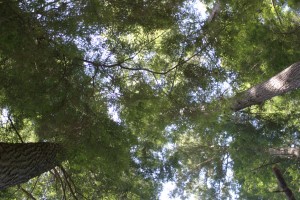Disturbance ecology of an old-growth hemlock forest
The Battell Research Forest is a 42 ha patch of uncut hemlock forest that was deeded to the College by Joseph Battell in the early 1900s. Battell stipulated in his will that the forest should remain “forever uncut”, and it has been managed since then in accordance with his wishes. Despite being uncut, it is far from undisturbed. In 1994, researchers published a reconstruction of the disturbance history of the forest that indicated frequent burning through the 1850s (Mann_etal_1994). Since then, fire has been absent as a disturbance agent and the forest canopy has instead been affected by a series of wind and ice storms. The Great Appalachian Windstorm of 1950 opened up dozens of gaps in the canopy (Mann et al., unpublished data), and a 1998 ice storm opened five large gaps.
A number of undergraduate theses have been written exploring the implications of a change from a fire-dominated to a wind and ice-dominated disturbance regime. These are linked below.
Weverka, A. 2009. Shifting Disturbance Regimes Change the Composition of an Old-Growth, Hemlock-Pine-Northern Hardwoods Forest in Central Vermont. Thesis, Department of Biology, Middlebury College. PDF: Weverka_2009.
Hewitt, R. 2005. Spatial Regeneration Patterns in Old-Growth Hemlock (Tsuga candensis) Forest Gaps in the Battell Research Forest, VT. Thesis, Department of Biology, Middlebury College.
Jewell, K. 2002. Forest Regeneration in 1998 Ice Storm Gaps In and Old-Growth Hemlock Forest in Vermont. Thesis, Department of Biology, Middlebury College. PDF: Jewell_2002

Leave a Reply
You must be logged in to post a comment.